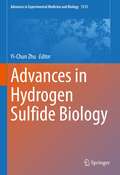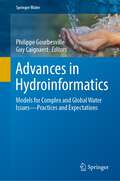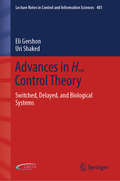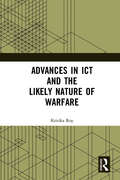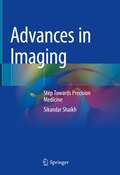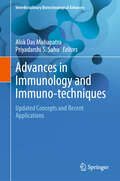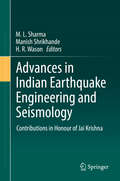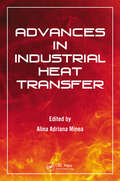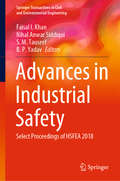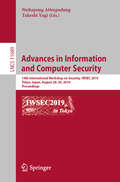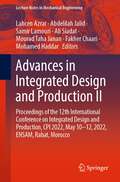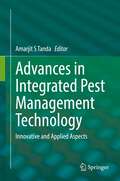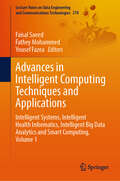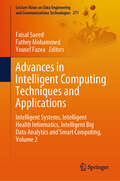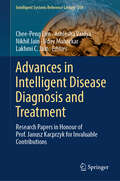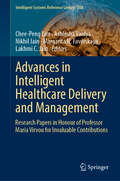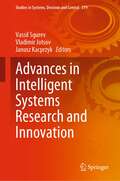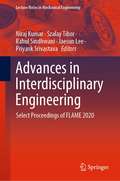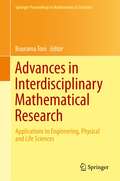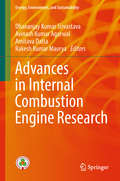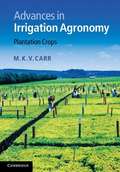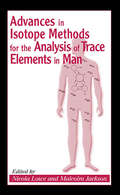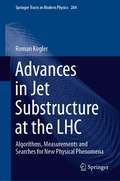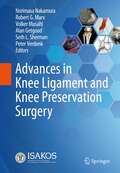- Table View
- List View
Advances in Hydrogen Sulfide Biology (Advances in Experimental Medicine and Biology #1315)
by Yi-Chun ZhuHydrogen sulfide (H2S) has emerged as an important gas signalling molecule in a series of organs/tissues, on the diseases of which it plays protective roles, such as proangiogenic effects in ischemic tissues, antiapoptotic effects in the cardiomyocytes, regularization of fatal arrhythmia in myocardial infarction, amelioration of inflammation in autoimmune diseases, modification of neuronal transmission, increase in sodium excretion from the kidney, and amelioration of insulin resistance, etc. This book focuses on the effect of hydrogen sulfide in cardiovascular system, immune system, nervous system, kidney, as well as on the metabolism of glucose and lipids and regulation of ion channels and so on. This book also provides the advances in the understanding of endogenous H2S metabolism and H2S protein targets, as well as H2S donors. It will benefit researchers in both academics and industry working on the underlying mechanism of H2S field and the future of translational medicine of H2S.
Advances in Hydroinformatics: Models for Complex and Global Water Issues—Practices and Expectations (Springer Water)
by Philippe Gourbesville Guy CaignaertThis book includes a collection of extended papers based on presentations given during the SIMHYDRO 2021 conference, held in Sophia Antipolis in June 2021 with the support of French Hydrotechnic Society (SHF). It focused on "Models for complex and global water issues—Practices and expectations”. The water field is continuously mobilizing models for addressing complex issues and new challenges. Within the context of the climate change, the water issues are exacerbated with the competition among uses. The limited water resources request from the modern societies to review some of the historical paradigms traditionally used and to promote new approaches for a sustainable management. The combined complexity and vulnerability of large urban environments request a deep understanding of water uses and environmental synergy. At the same time, water-related natural hazards are contentiously straightening modern societies that must adapt and implement a more resilient environment. In parallel, in the industrial sector, the search for a high level of efficiency for hydraulic machinery requests to simulate complex processes. Under all these situations, the models currently used represent only partly the physical phenomena involved, the scale of the processes, the hypothesis included within the different numerical tools, etc. The design and the operation of relevant models represent a challenging task for the modeller who is responsible of the knowledge part of a global system that is dedicated to support the decision makers. The book explores both the limitations and performance of current models and presents the latest developments based on new numerical schemes, high-performance computing, multi-physics and multi-scales methods, and better interaction with field or scale model data. It addresses the interests of practitioners, stakeholders, researchers, and engineers active in this field.
Advances in H∞ Control Theory: Switched, Delayed, and Biological Systems (Lecture Notes in Control and Information Sciences #481)
by Eli Gershon Uri ShakedAdvances in H∞ Control Theory is concerned with state-of-the-art developments in three areas:the extended treatment of mostly deterministic switched systems with dwell-time;the control of retarded stochastic state-multiplicative noisy systems; anda new approach to the control of biochemical systems, exemplified by the threonine synthesis and glycolytic pathways.Following an introduction and extensive literature survey, each of these major topics is the subject of an individual part of the book.The first two parts of the book contain several practical examples taken from various fields of control engineering including aircraft control, robot manipulation and process control. These examples are taken from the fields of deterministic switched systems and state-multiplicative noisy systems.The text is rounded out with short appendices covering mathematical fundamentals: σ-algebra and the input-output method for retarded systems.Advances in H∞ Control Theory is written for engineers engaged in control systems research and development, for applied mathematicians interested in systems and control and for graduate students specializing in stochastic control.
Advances in IC Engines and Combustion Technology: Select Proceedings of NCICEC 2019 (Lecture Notes in Mechanical Engineering)
by Ashwani K. Gupta Gulshan Sachdeva Hukam C. Mongia Pankaj ChandnaThis book comprises select peer-reviewed proceedings of the 26th National Conference on IC Engines and Combustion (NCICEC) 2019 which was organised by the Department of Mechanical Engineering, National Institute of Technology Kurukshetra under the aegis of The Combustion Institute-Indian Section (CIIS). The book covers latest research and developments in the areas of combustion and propulsion, exhaust emissions, gas turbines, hybrid vehicles, IC engines, and alternative fuels. The contents include theoretical and numerical tools applied to a wide range of combustion problems, and also discusses their applications. This book can be a good reference for engineers, educators and researchers working in the area of IC engines and combustion.
Advances in ICT and the Likely Nature of Warfare
by Kritika RoyThis book focuses on how advances in ICT have brought about a sea change in the way people work, live and share while also making them vulnerable. These advances exhibit a fundamentally reformed global context for development that has not just been restricted to the civilian domain but has simultaneously impacted the military domain. The exponential pace of advances in the field of Artificial Intelligence (AI), robotics, big data, quantum computing or IoT (Internet of Things) pioneers a significantly different vision of work and society. The current trends in warfighting present a very blurred picture of the future operating environment, but they give some shape to its likely direction. Military forces are trying to become much more flexible and have been adapting to these changes while emphasizing the importance of innovation and improvisation in order to counter challenges emanating from future scenarios. In this context, the book highlights the changing military strategies and tactics across nations vis-à-vis the hanging and emerging ICT technologies. It also highlights the importance of looking at present institutions, legal frameworks and principles as well as at the restraining factors inherent in realpolitik in order to understand if nation states are ready. Please note: Taylor & Francis does not sell or distribute the Hardback in India, Pakistan, Nepal, Bhutan, Bangladesh and Sri Lanka
Advances in Imaging: Step Towards Precision Medicine
by Sikandar ShaikhThis book covers all the advances in the imaging and elaborates on their applications and advantages. It provides step by step overview of the various advanced imaging modalities like molecular imaging, nano imaging, robotic imaging, stem cell imaging, optical imaging, immunoimaging, etc. It describes the applications of various advanced imaging modalities in pathologies like oncology, infection and inflammation and other conditions and provides the available therapeutic options with the help of these modalities. It also covers the detailed aspects of various modalities like ultrasound, CT, MRI, PET-CT, PET-MRI and other modalities. It includes the detailed explanation of various radiotracers, biomarkers and probes with many applications. Chapters cover detailed information at molecular level. The book is helpful for oncologists, hematologists, surgeons and many other specialists.
Advances in Immunology and Immuno-techniques: Updated Concepts and Recent Applications (Interdisciplinary Biotechnological Advances)
by Alok Das Mohapatra Priyadarshi S. SahuThis book aims to elucidate recent advancements in immunology, presenting a curated selection of topics not typically covered in conventional immunology textbooks. Each chapter features a comprehensive outline, an abstract, a glossary, and relevant figures, making this volume an accessible and user-friendly resource for seeking to enhance their understanding of these subjects. This publication will appeal to university researchers, R&D professionals, and graduate students in immunobiology who wish to update and deepen their knowledge of emerging and applied concepts in the field.
Advances in Indian Earthquake Engineering and Seismology: Contributions in Honour of Jai Krishna
by M. L. Sharma Manish Shrikhande H. R. WasonThis edited volume is an up-to-date guide for students, policy makers and engineers on earthquake engineering, including methods and technologies for seismic hazard detection and mitigation. The book was written in honour of the late Professor Jai Krishna, who was a pioneer in teaching and research in the field of earthquake engineering in India during his decades-long work at the University of Roorkee (now the Indian Institute of Technology Roorkee). The book comprehensively covers the historical development of earthquake engineering in India, and uses this background knowledge to address the need for current advances in earthquake engineering, especially in developing countries. After discussing the history and growth of earthquake engineering in India from the past 50 years, the book addresses the present status of earthquake engineering in regards to the seismic resistant designs of bridges, buildings, railways, and other infrastructures. Specific topics include response spectrum superposition methods, design philosophy, system identification approaches, retaining walls, and shallow foundations. Readers will learn about developments in earthquake engineering over the past 50 years, and how new methods and technologies can be applied towards seismic risk and hazard identification and mitigation.
Advances in Industrial Heat Transfer (Heat Transfer)
by Alina Adriana MineaAdvances in Industrial Heat Transfer presents the basic principles of industrial heat transfer enhancement. Serving as a reference and guide for future research, this book presents a complete approach, from redesigning equipment to the use of nanofluids in industry.Based on the latest methods of the experiment and their interpretation, this book pr
Advances in Industrial Safety: Select Proceedings of HSFEA 2018 (Springer Transactions in Civil and Environmental Engineering)
by S. M. Tauseef Nihal Anwar Siddiqui Faisal I. Khan B. P. YadavThis book presents the proceedings of the International Conference on Health, Safety, Fire, Environment, and Allied Sciences. It highlights latest developments in the field of science and technology aimed at improving health and safety in the workplace. The volume comprises content from leading scientists, engineers, and policy makers discussing issues relating to industrial safety, fire hazards and their management in industry, forests and other settings. Also dealt with are issues of occupational health in engineering, process and agricultural industry and protection against incidents of arson and terror attacks. The contents of this volume will be of interest to researchers, practitioners, and policy makers alike.
Advances in Information and Computer Security: 14th International Workshop on Security, IWSEC 2019, Tokyo, Japan, August 28–30, 2019, Proceedings (Lecture Notes in Computer Science #11689)
by Nuttapong Attrapadung Takeshi YagiThis book constitutes the refereed proceedings of the 14th International Workshop on Security, IWSEC 2019, held in Tokyo, Japan, in August 2019. The 18 regular papers and 5 short papers presented in this volume were carefully reviewed and selected from 61 submissions. They were organized in topical sections named: Public-Key Primitives; Cryptanalysis on Public-Key Primitives; Cryptographic Protocols; Symmetric-Key Primitives; Malware Detection and Classification; Intrusion Detection and Prevention; Web and Usable Security; Cryptanalysis on Symmetric-Key Primitives; and Forensics.
Advances in Integrated Design and Production II: Proceedings of the 12th International Conference on Integrated Design and Production, CPI 2022, May 10–12, 2022, ENSAM, Rabat, Morocco (Lecture Notes in Mechanical Engineering)
by Fakher Chaari Mohamed Haddar Samir Lamouri Ali Siadat Lahcen Azrar Abdelilah Jalid Mourad Taha JananThis book reports on innovative concepts and practical solutions at the intersection between engineering design, production and industrial management. It covers cutting-edge design, modeling and control of dynamic and multiphysics systems, knowledge management systems in industry 4.0, cyber-physical production systems, additive and sustainable manufacturing and many other related topics. It also highlights important collaborative works between different countries and between industry and universities. Gathering the proceedings of the 12th International Conference on Integrated Design and Production, CPI 2022, held on May 10-12, 2022, at École Nationale Supérieure d'Arts et Métiers (ENSAM), in Rabat, Morocco, this book gathers carefully peer-reviewed chapters, with extensive information for researchers and professionals in the broad area of engineering design, production and management.
Advances in Integrated Pest Management Technology: Innovative and Applied Aspects
by Amarjit S TandaThe UN's Food and Agriculture Organization defines integrated pest management (IPM) as "the careful consideration of all available pest control techniques and subsequent integration of appropriate measures that discourage the development of pest populations and keep pesticides and other interventions to levels that are economically justified and reduce or minimize risks to human health and the environment. IPM emphasizes the growth of a healthy crop with the least possible disruption to agro-ecosystems and encourages natural pest control mechanisms. "Although this is a concept championed since the 70s, recent advances in agricultural biotechnologies and unfortunately, new problems brought on by global climate change warrant a reevaluation of how IPM can be implemented. This book aims at bringing out a comprehensive collection of information on all aspects of advances in integrated pest management technology in agriculture systems worldwide. The main focus of this book is to address the nano-biotechnology as sustainable solutions, biogenetic insect resistant plants in integrated pest management technology (IPMT), and DNA barcoding of insects and role of protease inhibitors in recent management trends. It also highlights the advances in integrated management of insect pests of stored grains, and use of bee pollinator’s as a livelihood security to the people worldwide. Step-by-step descriptions, accompanied by numerous photographs and schematic drawings, are provided on IPMT under changing climate, and habitat manipulation in crops. This book thus provides a forward-looking foundation for IPMT systems and its use in crop production.
Advances in Intelligent Computing Techniques and Applications: Intelligent Systems, Intelligent Health Informatics, Intelligent Big Data Analytics and Smart Computing, Volume 1 (Lecture Notes on Data Engineering and Communications Technologies #210)
by Faisal Saeed Fathey Mohammed Yousef FazeaThis book presents the papers included in the proceedings of the 7th International Conference of Reliable Information and Communication Technology 2023 (IRICT 2023) that was held in Pulai Springs Resorts, Johor, Malaysia on 27-28, December 2023. IRICT 2023 is organized by the Yemeni Scientists Research Group (YSRG) and Big Data Center in Universiti Teknologi Malaysia (Malaysia) in collaboration with Association for Information Systems – Malaysia Chapter (MyAIS) and College of Engineering, IT and Environment at Charles Darwin University (Australia). IRICT2023 is a forum for the presentation of technological advances in the field of Information and Communication Technology. The main theme of the conference is “Advances in Intelligent Computing Techniques and Applications”. The book discusses several research topics such as Health Informatics, Artificial Intelligence, Soft Computing, Data Science, Big Data Analytics, Internet of Things (IoT), Intelligent Communication Systems, Cyber Security, and Information System. These papers were presented in three parallel sessions during the two days.
Advances in Intelligent Computing Techniques and Applications: Intelligent Systems, Intelligent Health Informatics, Intelligent Big Data Analytics and Smart Computing, Volume 2 (Lecture Notes on Data Engineering and Communications Technologies #211)
by Faisal Saeed Fathey Mohammed Yousef FazeaThis book presents the papers included in the proceedings of the 7th International Conference of Reliable Information and Communication Technology 2023 (IRICT 2023) that was held in Pulai Springs Resorts, Johor, Malaysia on 27-28, December 2023. IRICT 2023 is organized by the Yemeni Scientists Research Group (YSRG) and Big Data Center in Universiti Teknologi Malaysia (Malaysia) in collaboration with Association for Information Systems – Malaysia Chapter (MyAIS) and College of Engineering, IT and Environment at Charles Darwin University (Australia). IRICT2023 is a forum for the presentation of technological advances in the field of Information and Communication Technology. The main theme of the conference is “Advances in Intelligent Computing Techniques and Applications”. The book discusses several research topics such as Health Informatics, Artificial Intelligence, Soft Computing, Data Science, Big Data Analytics, Internet of Things (IoT), Intelligent Communication Systems, Cyber Security, and Information System. These papers were presented in three parallel sessions during the two days.
Advances in Intelligent Disease Diagnosis and Treatment: Research Papers in Honour of Prof. Janusz Kacprzyk for Invaluable Contributions (Intelligent Systems Reference Library #259)
by Lakhmi C. Jain Chee-Peng Lim Ashlesha Vaidya Nikhil Jain Uday MahorkarThe book delves into innovations in AI and related computing paradigms for disease detection and diagnosis. The collected chapters elucidate the use of a variety of AI and related methodologies to address specific medical challenges. From detecting pancreatic cancer, classifying micro-emboli in stroke diagnosis, to segmenting brain tumours from MRI data, and more, the culmination of these studies underscores the transformative impact AI and digital technologies can have on healthcare, emphasising their potential to enhance medical treatment and improve patient care.
Advances in Intelligent Healthcare Delivery and Management: Research Papers in Honour of Professor Maria Virvou for Invaluable Contributions (Intelligent Systems Reference Library #258)
by Lakhmi C. Jain Margarita N. Favorskaya Chee-Peng Lim Ashlesha Vaidya Nikhil JainThis book unveils the dynamic fusion of artificial intelligence (AI) and related innovations in healthcare delivery and management. The collected chapters delve into innovative and intelligent methods for improving healthcare services, from electronic health records management, robotics and AI in healthcare, to data-driven decision-making. Readers can discover how AI-based methodologies empower different facets of healthcare delivery and management, building a future where digital technologies are leveraged to enhance the quality and accessibility of healthcare services.
Advances in Intelligent Systems Research and Innovation (Studies in Systems, Decision and Control #379)
by Janusz Kacprzyk Vassil Sgurev Vladimir JotsovThis book represents the experience of successful researchers from four continents on a broad range of intelligent systems, and it hints how to avoid anticipated conflicts and problems during multidisciplinary innovative research from Industry 4.0 and/or Internet of Things through modern machine learning, and software agent applications to open data science big data/advance analytics/visual analytics/text mining/web mining/knowledge discovery/deep data mining issues. The considered intelligent part is essential in most smart/control systems, cyber security, bioinformatics, virtual reality, robotics, mathematical modelling projects, and its significance rapidly increases in other technologies. Theoretical foundations of fuzzy sets, mathematical and non-classical logic also are rapidly developing.
Advances in Interdisciplinary Engineering: Select Proceedings of FLAME 2020 (Lecture Notes in Mechanical Engineering)
by Niraj Kumar Rahul Sindhwani Szalay Tibor Jaesun Lee Priyank SrivastavaThis book comprises the select proceedings of the International Conference on Future Learning Aspects of Mechanical Engineering (FLAME) 2020. This volume focuses on several emerging interdisciplinary areas involving mechanical engineering. Some of the topics covered include automobile engineering, mechatronics, applied mechanics, structural mechanics, hydraulic mechanics, human vibration, biomechanics, biomedical Instrumentation, ergonomics, biodynamic modeling, nuclear engineering, and agriculture engineering. The contents of this book will be useful for students, researchers as well as professionals interested in interdisciplinary topics of mechanical engineering.
Advances in Interdisciplinary Mathematical Research: Applications to Engineering, Physical and Life Sciences (Springer Proceedings in Mathematics & Statistics #37)
by Bourama ToniThis volume contains the invited contributions to the Spring 2012 seminar series at Virginia State University on Mathematical Sciences and Applications. It is a thematic continuation of work presented in Volume 24 of the Springer Proceedings in Mathematics & Statistics series. Contributors present their own work as leading researchers to advance their specific fields and induce a genuine interdisciplinary interaction. Thus all articles therein are selective, self-contained, and are pedagogically exposed to foster student interest in science, technology, engineering and mathematics, stimulate graduate and undergraduate research, as well as collaboration between researchers from different areas. The volume features new advances in mathematical research and its applications: anti-periodicity; almost stochastic difference equations; absolute and conditional stability in delayed equations; gamma-convergence and applications to block copolymer morphology; the dynamics of collision and near-collision in celestial mechanics; almost and pseudo-almost limit cycles; rainbows in spheres and connections to ray, wave and potential scattering theory; null-controllability of the heat equation with constraints; optimal control for systems subjected to null-controllability; the Galerkin method for heat transfer in closed channels; wavelet transforms for real-time noise cancellation; signal, image processing and machine learning in medicine and biology; methodology for research on durability, reliability, damage tolerance of aerospace materials and structures at NASA Langley Research Center. The volume is suitable and valuable for mathematicians, scientists and research students in a variety of interdisciplinary fields, namely physical and life sciences, engineering and technology including structures and materials sciences, computer science for signal, image processing and machine learning in medicine.
Advances in Internal Combustion Engine Research (Energy, Environment, and Sustainability)
by Amitava Datta Avinash Kumar Agarwal Rakesh Kumar Maurya Dhananjay Kumar SrivastavaThis book discusses all aspects of advanced engine technologies, and describes the role of alternative fuels and solution-based modeling studies in meeting the increasingly higher standards of the automotive industry. By promoting research into more efficient and environment-friendly combustion technologies, it helps enable researchers to develop higher-power engines with lower fuel consumption, emissions, and noise levels. Over the course of 12 chapters, it covers research in areas such as homogeneous charge compression ignition (HCCI) combustion and control strategies, the use of alternative fuels and additives in combination with new combustion technology and novel approaches to recover the pumping loss in the spark ignition engine. The book will serve as a valuable resource for academic researchers and professional automotive engineers alike.
Advances in Irrigation Agronomy
by Jerry Knox M. K. Carr Rob LockwoodIrrigation has been used for thousands of years to maximize the performance, efficiency and profitability of crops and it is a science that is constantly evolving. This potential for improved crop yields has never been more important as population levels and demand for food continue to grow. Recognising the need for a coherent and accessible review of international irrigation research, this book examines the factors influencing water productivity in individual crops. It focuses on nine key plantation/industrial crops on which millions of people in the tropics and subtropics depend for their livelihoods (banana, cocoa, coconut, coffee, oil palm, rubber, sisal, sugar cane and tea). Linking crop physiology, agronomy and irrigation practices, this is a valuable resource for planners, irrigation engineers, agronomists and producers concerned with the international need to improve water productivity in agriculture in the face of increased pressure on water resources.
Advances in Isotope Methods for the Analysis of Trace Elements in Man (Modern Nutrition)
by Nicola Lowe Malcolm JacksonThere is increasing evidence that even minute amounts of trace elements can have profound effects on the human body. Advances in Isotope Methods for the Analysis of Trace Elements in Man describes new methods that are being developed to understand normal and abnormal trace element nutrition and metabolism. This book includes a wealth of pr
Advances in Jet Substructure at the LHC: Algorithms, Measurements and Searches for New Physical Phenomena (Springer Tracts in Modern Physics #284)
by Roman KoglerThis book introduces the reader to the field of jet substructure, starting from the basic considerations for capturing decays of boosted particles in individual jets, to explaining state-of-the-art techniques. Jet substructure methods have become ubiquitous in data analyses at the LHC, with diverse applications stemming from the abundance of jets in proton-proton collisions, the presence of pileup and multiple interactions, and the need to reconstruct and identify decays of highly-Lorentz boosted particles. The last decade has seen a vast increase in our knowledge of all aspects of the field, with a proliferation of new jet substructure algorithms, calculations and measurements which are presented in this book. Recent developments and algorithms are described and put into the larger experimental context. Their usefulness and application are shown in many demonstrative examples and the phenomenological and experimental effects influencing their performance are discussed. A comprehensive overview is given of measurements and searches for new phenomena performed by the ATLAS and CMS Collaborations. This book shows the impressive versatility of jet substructure methods at the LHC.
Advances in Knee Ligament and Knee Preservation Surgery
by Robert G. Marx Norimasa Nakamura Volker Musahl Alan Getgood Peter Verdonk Seth L. ShermanThis comprehensive book offers an overview of the latest advances in knee ligament and knee preservation surgery, including cartilage, meniscus, and osteotomy procedures.Designed to offer practical guidance on the management of complex knee problems, it presents clinical scenarios as well as recommendations by leading international experts. Written in collaboration with ISAKOS and drawing on a variety of perspectives it is invaluable tool for orthopedic and sports medicine surgeons.
